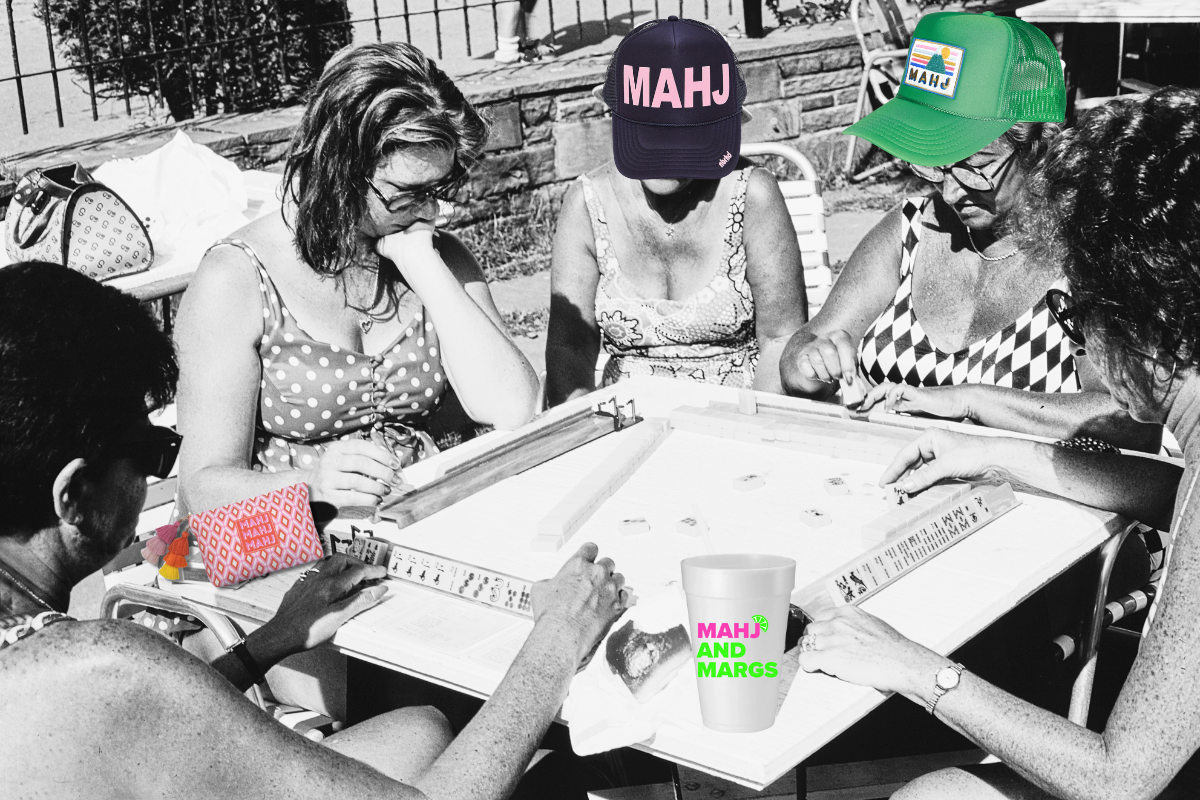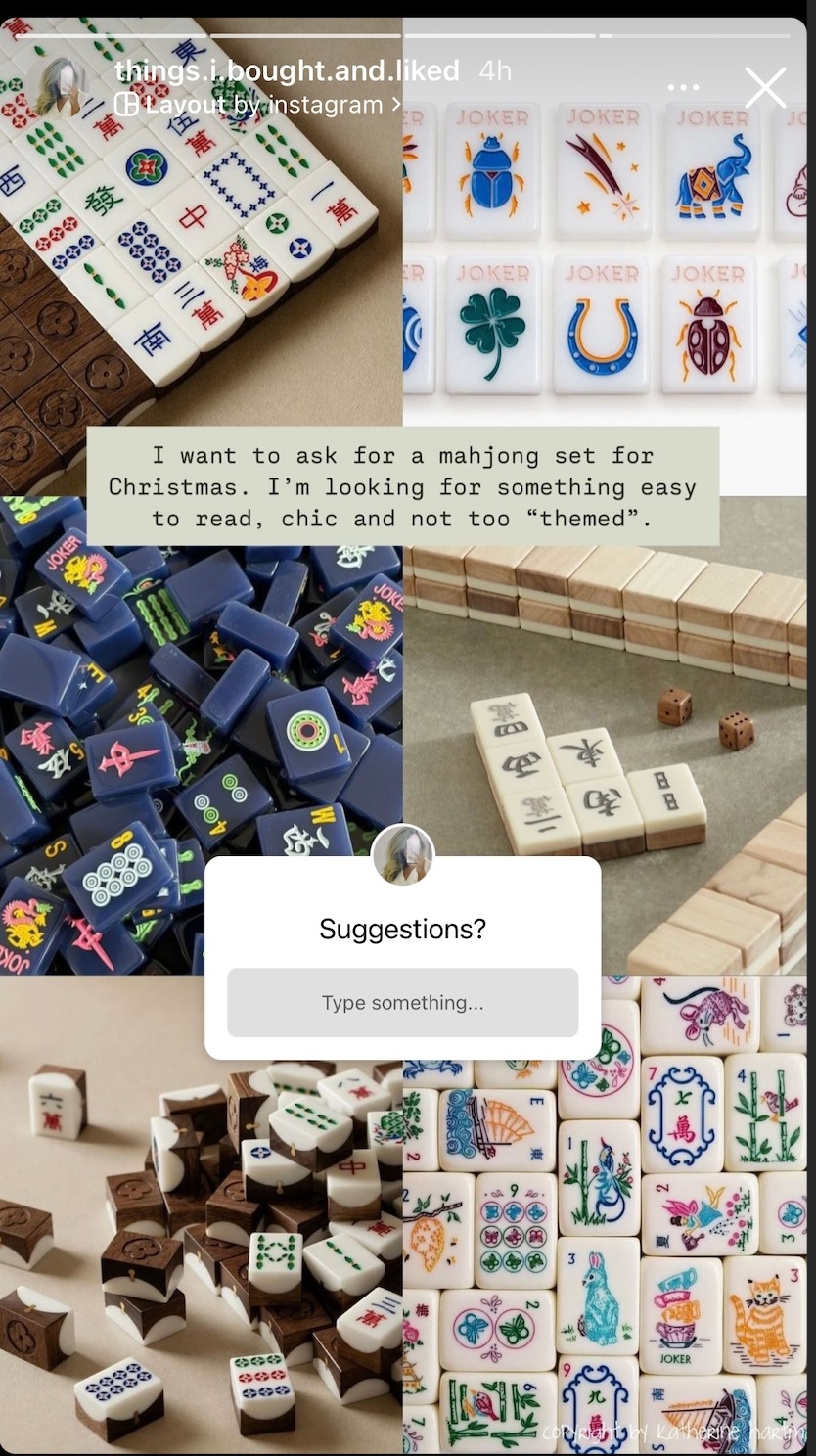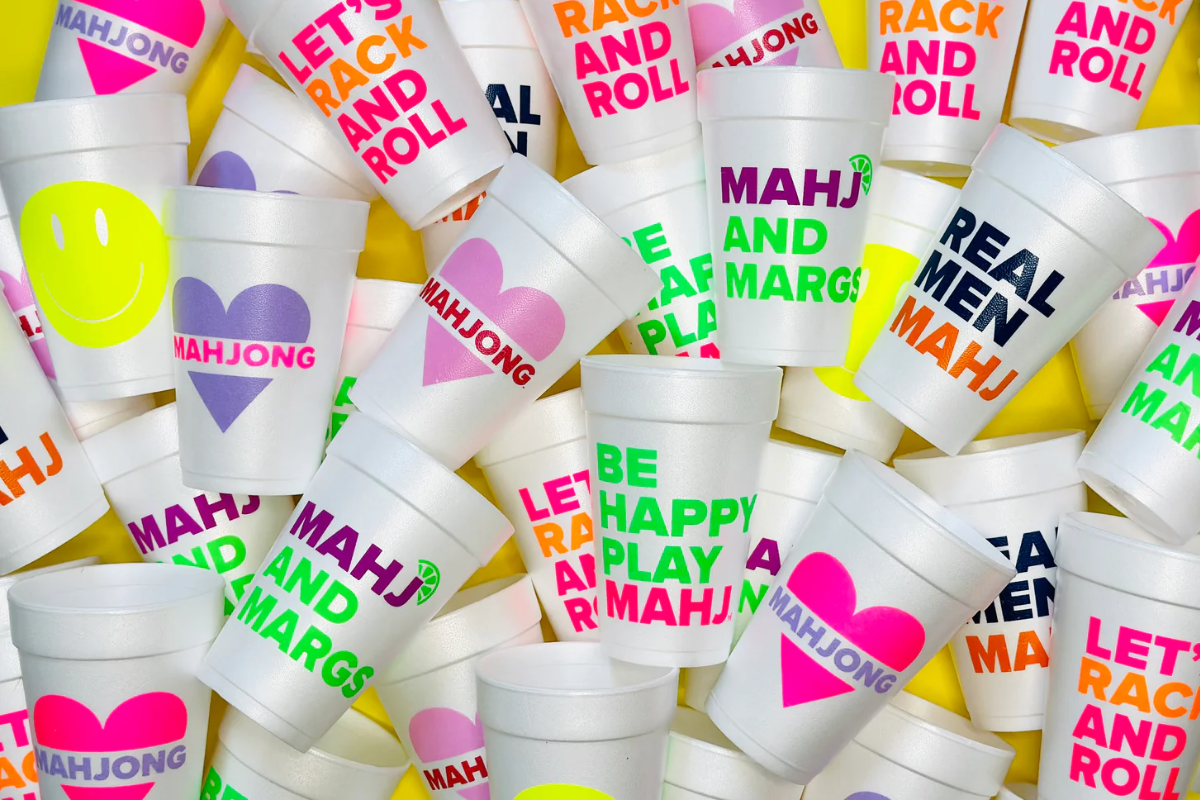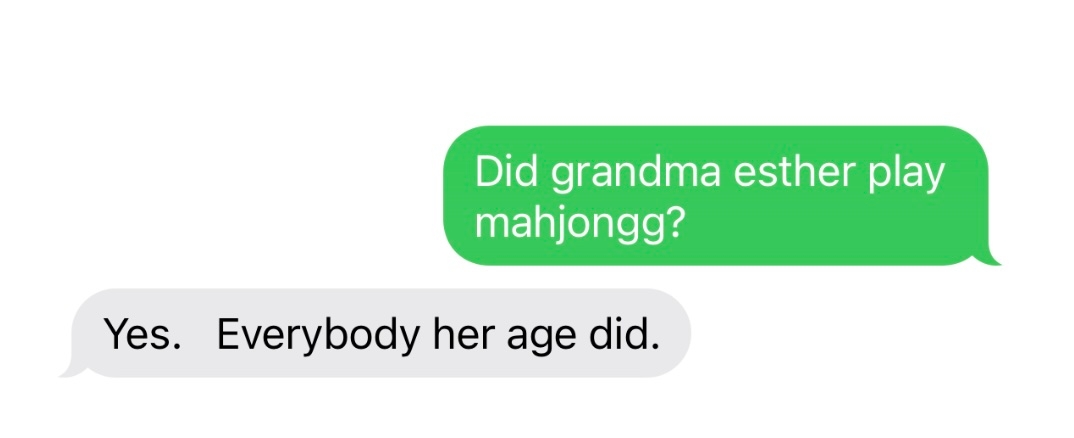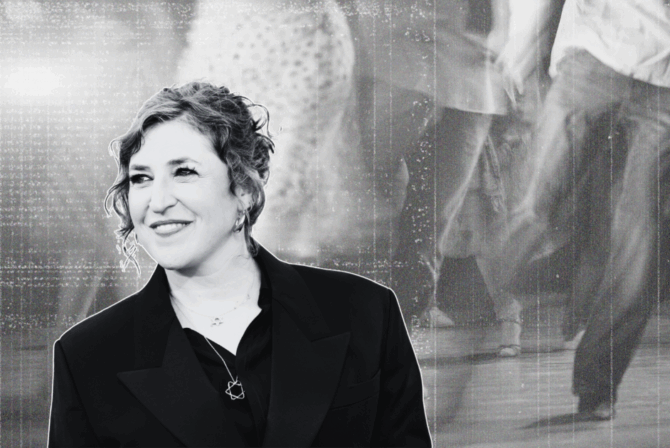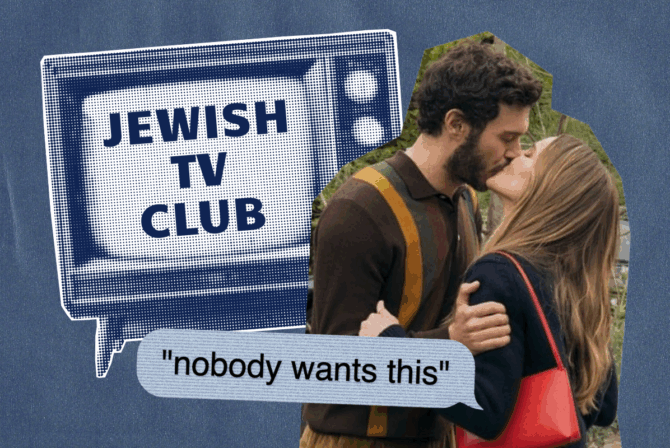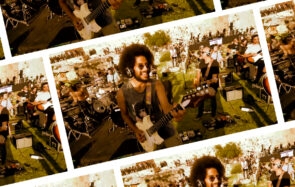On Sunday mornings when I drop my daughter off at Sunday school, I pass a conference room at the synagogue where a handful of older women sit quietly playing mah jongg. The game is advertised in the temple newsletter with a casual, “If you’re able, shlep a mahj set. If you’d like, bring a snack to share.” This is what I’d always thought of mah jongg as: a popular Chinese game, brought to America in the 1920s, beloved by many Americans initially but abandoned quickly by most — except for older Jewish women, who passed the game through their circles and onto their daughters.
But last week, an Instagram influencer I follow — a woman in her 30s with nearly 600,000 Instagram followers, who is not Jewish or Chinese and who lives in Houston and usually posts about fancy candles, Alo Yoga pants, trendy sneakers and melatonin gummies — posted this story:
It reminded me that one of my friends had mentioned recently that the preschool moms in her suburban Dallas city were trying to start a weekly mahj game. It was one of the first times I had heard one of my peers use the word “mahj” (and almost certainly the first time I’d heard someone not Jewish say it). I also remembered that another fashion writer and influencer I’ve followed for a long time, Grace Atwood, moved from New York City to Savannah, Georgia a few years ago and took up mah jongg there.
Why are all of these young Southern women suddenly playing this game previously associated with bubbes? I started searching. And I found that mah jongg is having a serious moment in the South.
The game has always gone in and out of fashion — I found articles from 2010, 2019 and 2021 claiming that mah jongg was making a comeback. Plenty of companies, like Modern Mahjongg, who has been around since 2019 and is hosting Kveller’s Master Mah Jongg class this month (sign up here!), want to keep the game relevant for today’s audience. Generally when mah jongg makes a comeback, according to these articles, it’s in Jewish or Chinese circles, where the drivers of the trend are inspired by their family history with the game. And the East Coast and West Coast current iterations of mah jongg largely follow that pattern. The New York Jewish Week recently profiled Mah Jongg Social, a weekly no-frills game that’s been held in Bryant Park since 2012. Green Tile Social Club in New York and Mahjongg Mistress in Los Angeles are both wildly popular, super chic and were created with a nod to their Asian heritage. In the LA Times, the creators of Mahjongg Mistress conjecture that mah jongg is trending right now in response to rising Asian hate.
“It’s a game that has historically been used in communities, specifically immigrant communities, Chinese, Cantonese and Jewish, specifically, in America to bring people together,” Angie Lin, one of Mahjongg Mistress’s creators, told the LA Times.
But the emerging Southern interpretation, with its very specific preppy aesthetic and mah jongg nights at champagne bars, which became more visible in the last four years and fully exploded this year, feels less rooted in tradition.
I grew up in Baton Rouge, a city of less than 1,000 Jews. Nearly every day working here at Kveller, where most of our staff is either from or has lived in New York City, I learn about something Jewish I didn’t know about. Rainbow cookies at a shiva. Not toasting a fresh bagel (and the utter disdain for blueberry bagels). The nostalgic reverence for the Catskills. Mah jongg is one of those things — I’m not sure I even knew about it until I moved to Minneapolis as an adult. Working at the Jewish Federation there, I often had meetings at the Jewish country club, where tables of older women playing mah jongg dotted the dark wood-paneled lobby.
So when I saw an article in 225, the monthly lifestyle magazine in Baton Rouge, about the mah jongg trend currently taking over the city, it was quite jarring. The scene laid out in the article doesn’t look anything like the mah jongg I’ve encountered, certainly very different from the resurgence being spearheaded by Gen-Z Asian women as well. The photos look like they belong in the society page of that same magazine. The women are wearing floral dresses you might see at a bridal shower and the room is decorated with the bamboo chairs I deemed too expensive for my wedding.
The article focuses mostly on a company called Mahjong Rouge, two women who offer mah jongg lessons throughout Baton Rouge. They started their business in April of this year and have nearly 2,000 Instagram followers. Through their Instagram I found dozens of other mah jongg-centric Instagram accounts, all with similar logos and content, and realized that they are all certified teachers through a few different companies who provide them with teacher training, branding training, sales leads and entrance into affiliate programs so that they get a cut when their students purchase certain mah jongg accessories. In Chattanooga, Tennessee, The Mahjong Social Chatt is hosting a palm royale themed mah jongg night. Soda City Mahj in the Midlands of South Carolina has perfected the mahj selfie, with carefully placed manicured hands hovering over tiles strewn just so. Geaux Mahjong in Bay St. Louis, Mississippi rings a gong before each game. Mahjong & Magnolias in Nashville posts a monthly mah jongg tablescape inspiration board. Tyler Mahj Club in Tyler, Texas hosted Cinco de Mahjo.
Also interesting is the cottage industry that’s popped up around this mah jongg explosion: trucker hats that say MAHJ, “margaritas & mahjong” sweatshirts, floating mahjongg tables, wine tumblers that say “It’s five o’crak somewhere” and the same decorated styrofoam cups I used to drink warm beer out of before Louisiana State University football games.
There are mah jongg party decorations for Easter, Christmas and “Mahji” Gras. Influencers who play mah jongg recommend you carry your set in monogrammed totes and link you to $250 tablecloths so your tiles don’t mark up your table. My friend in Dallas told me she’s been tempted by a $1250 table (it’s very cute). The biggest mah jongg accessory company — and the one all these Southern influencers advertise on their Instagram page — is The Mahjong Line, who in 2021 went viral for explaining that they created their minimal mah jongg sets because “nothing came close to mirroring (the founder’s) style and personality.” They later apologized, saying, “While our intent is to inspire and engage with a new generation of American mahjong players, we recognize our failure to pay proper homage to the game’s Chinese heritage.”
When I recently asked on my own Instagram account if anyone else had noticed an uptick in influencers playing mah jongg, my DMs were suddenly full of links to influencers in the South — mostly clustered in Texas and Oklahoma — all with the same floral preppy approach to the game. I read about a mah jongg garden party in Nashville where guests were served deviled eggs with caviar and a strawberry thyme lemonade cocktail. I found a House Beautiful article from May stating that “mahjong rooms are having a moment.” I saw so many women with separate and nearly identical mah jongg teaching Instagram accounts that they started to blur the line between side hustle and MLM.
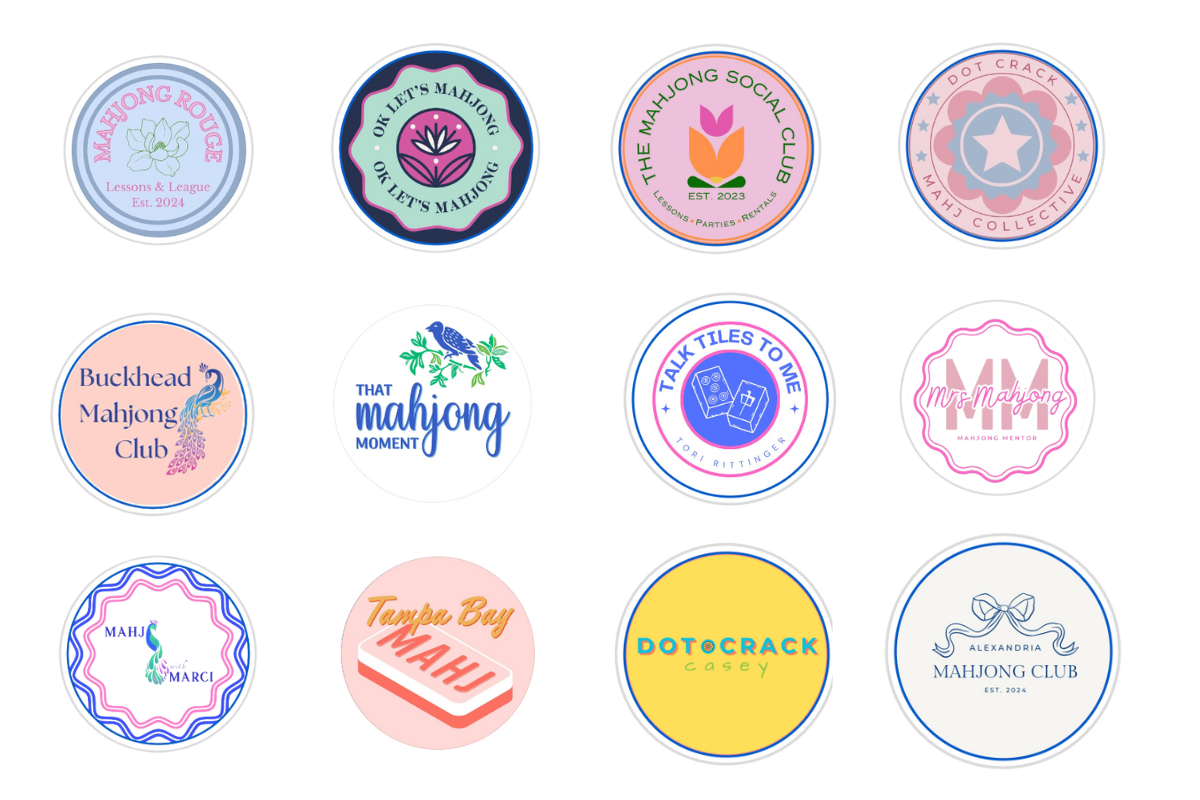
Just a handful of Southern mah jongg teacher Instagram account logos, most of which were started in the last year
At the same time, a Jewish friend in New Jersey sent me a picture of her mahj group: a normal card table with a single bowl of M&Ms and three women in their PJs.
A few Southern Jewish friends messaged me to say how annoyed they were by the influx of non-Jewish white women suddenly making mah jongg their entire personality. I wonder if this sentiment — or at least the lack of recognition of the Jewish history involved in the game — was the impetus for two Southern mah jongg teachers, Gabby Spatt and Rachel Mazer, to create the company Mahji Mazels. Both Gabby and Rachel are registered teachers with Oh My Mahj, whose website only briefly mentions Jewish women in their history of the game. The Mahji Mazels tagline is “Mahjong didn’t start with us. And it won’t end with us.” Their about page reads:
“Mahj is having a major moment. And we love that for mahjong, but we’re starting to feel a little left out…As we watch the popularity and commercial success of the game rise, our part of the story needs to be included. It is crucial now, more than ever that we shout from the rooftops MAHJONG with a side of MAZEL! We must recognize and honor the rich history of mahjong among Jewish American Women. Mahjong didn’t start with us. And it won’t end with us. We’ll continue to kibitz (chat) and nosh (snack) with our friends around the mahjong table and pass our beautiful tiles down to our grandchildren along with our stories.”
They offer a script for fellow teachers with the game’s history — heavy emphasis on the Jewish interest in the game — and share their personal stories of generational mah jongg, including some Yiddish definitions that may have been common among mah jongg players like their grandparents.
I’m not sure how I personally feel about all this. I don’t remember hearing anyone in my family talk about mah jongg, so I didn’t think I had a stake in this game. You may be thinking to yourself, “Daci, your Grandma Esther Spielberger, who was in her 30s in the 1940s, definitely played mah jongg,” and this text from my dad proves your point:
I will admit that seeing mah jongg branded and celebrated in a modern way makes me want to learn to play far more than the note at the bottom of my temple’s newsletter did. (I’ll be signing up for the Kveller class!) Mainly, I wonder if the different factions of mah jongg enthusiasts know about each other — and how they feel about its different iterations.
And I wonder if, one day, my own grandkids will ask if Grandma Daci ever played mah jongg, and they’ll be told of course, everybody her age did.
